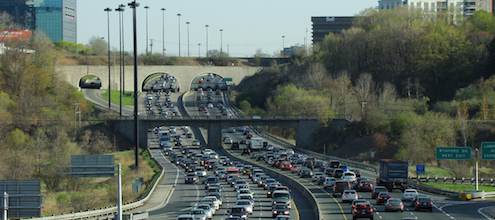
Fighting traffic with congestion pricing
The following is an excerpt from The Policy Opportunity of Our Generation: Ecofiscal Reform in Canada’s Provinces and Cities, published in Public Sector Digest, February 2015, and made available online January 15th. This is the third of a four-part blog series that highlights how ecofiscal policies can help cities and provinces conserve water, fight traffic and reduce waste.
Being stuck in traffic is the bane of many urbanites’ existence. We saw this most recently in Canada during Toronto’s mayoral election, where transportation was arguably the single most important issue for voters. Bumper-to-bumper frustration has real economic costs, both in accident damage and loss of time. Gridlock costs the city of Toronto between $6 and $11 billion annually. Similar frustrations in Vancouver, Calgary, Montreal and Halifax are mounting quickly.
Evidence suggests that widening roads, or even building new ones, doesn’t solve the problem because it induces more drivers to take to their cars. In fact, it often makes things worse. In Los Angeles, for example, a 5-year, $1 billion project to widen Interstate 450 resulted in more cars on the road and the traffic moving somewhat slower than it did before the expansion. Total frustration and wasted time simply increased.
What has solved the problem is congestion pricing. The city of London, England employed such a strategy in 2003 to reduce congestion in one of its most high-traffic zones, in the centre of the city. Vehicles entering the zone during peak periods are charged a fixed daily fee, with exemptions and fee reductions for those living in the zone, as well as for public buses and low-emissions vehicles. Traffic in the area fell almost immediately after the charge was introduced and by as much as 36 percent in the first 10 years of the program. The significant amount of revenue raised by the program is reinvested directly into local transit improvements.
Examples of congestion pricing in Canada, however, are few and far between. Ontario’s highway 407 is likely the largest and closest example to a pricing system. In 2007 it became the world’s first all-electronic, barrier-free tolled highway. While some of the toll revenue goes toward the highway’s maintenance, profits go back to its private owners—a fact that may have soured public opinion of such a program.
The reality is that congestion pricing is likely to be most effective in concert with improvements in the availability of public transit. Toronto arguably faces the worst congestion problem of any city in the country, and only 22.4 percent of commuters use public transit. How congestion pricing can play a role in fighting Canada’s traffic woes is a question that must be asked in the context of a much broader conversation. What kinds of transit systems are needed by Canada’s 21st century cities?
>>Read the next post on reducing waste




1 comment
I like the comments from your commissioners.
Many of your ideas, areas of carbon reduction, are underway around the world and are more longterm from the Ecofiscal Commission objectives.
One of the alternatives for Provinces is to follow British Columbia’s leadership and impose a Fee and Dividend polluter pay model for Carbon.
Manning says do it but do not call it a Tax. Call it polluter pay program, PPP
Pope Francis is advocating protecting our environment.
Do not wait until you complete your report! Report out now on the PPP.
One change from British Columbia’s Use James Hansen’s .
Collect fee like B.C. Make it Revenue Neutral, Disperse dividends based on one part for each adult and half a point p[er child up to two children.\
Incentive will be there for rich polluters. Frugal rich will not be over charged.
Poor people who do not have the ability to pollute will earn a large dividend and they should because they will have the least ability to adjust to climate change.
So, all of your commissioners are in favour of a Revenue Neutral PPP. This type of program is compatible with Cap and Trade. BC has proven that it does not hurt the economy.
I was there 11 years, William Marsden is right. Fools Rule!
RECOMMENDATION! The Ecofiscal Commission should use the James Hansen proposal and calculate average annual fee costs for the poor woman, the average person, the frugal rich man and the high spending rich person and the dividend each would be returned based on one part per adult and a half part per child up to two children. Base it on $30 per tonne which is BC’s carbon fee and take it up to $80 per tonne. Let’s see if we do not achieve four objectives.
1. Polluter pays according to the amount he pollutes.
2. Poor people and low carbon users receive larger dividends.
3. All people receive benefits from less pollution of the environment.
4. All people are incented equally to lower their pollution of our atmosphere.
Comments are closed.